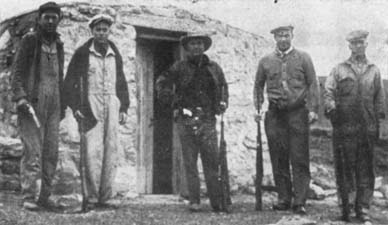
Interesting Side Lights
Hodgeman County, in the early years, proved attractive to all types of people. Families of small means came in hopes of establishing homes and were willing to work hard toward that end; there were people of nomadic temperament who sought a utopia they were unable to find and soon pursued their dream elsewhere; some were promoters, strutting their brief time before a gullible public, with wild-eyed promises of development and affluence that were impossible of fulfillment. There were men of vision who could see the real promise of the future and who set about building a slower growing but enduring economy. Some had grandiose dreams of cattle empires and widespread land holdings. Among these latter were men like Henry Mudge whose ranch spread covered parts of Center, Valley and Marena Townships. The history of his ranching exploits was recorded in fascinating detail under the authorship of Margaret Caldwell in several 1957 issues of the Jetmore Republican. Fantastic tales are told of the excesses and extravagances of the gay young blade of English descent and manners who hailed from Boston, but who hardly exemplified the popular conception of the proper Bostonian. He built huge sheep corrals, stables for fine riding and carriage horses as well as horses and cow ponies, and a spacious ranch home where he entertained lavishly. His extravagances were matched only by his ignorance of all things connected with successful ranching, and after several years the pretentious scheme was abandoned at great financial loss. Other men went at their ranching in a less spectacular way and at a much more modest scale and reaped worthwhile returns for their efforts. The 1887 Handbook of Hodgeman County speaks of numerous ranches over the county, many of which were small by modern standards. It lists such names as Gallaway Grange, Brookside, Kenyon Park, Spring Brook, Catalpa Lawn, Riverside, Nodaway Ranch, Graceland, Pomona Park, Long View, Wier's Gem Park, and others. Just how many of these were bona fide ranches or stock farms, is difficult to determine, though the Handbook's descriptions make exciting reading - which - no doubt, was the purpose of the writer who probably had an ulterior motive in his enthusiasm. But through the years there have been many real and thriving ranches in the county. Early fences used posts of native stone quarried at the expense of great labor from local quarries and transported by stone sleds or heavy wagons to the place where they were to be used. A blurb, the Handbook again speaks of them as "yielding to the chisel, plane or saw as readily as white pine." They were not susceptible to termites or rot, and certainly they could not be stolen for firewood. Their permanence is attested by the fact that many of these posts are still in use, though they are gradually being replaced.

Small towns were laid out by promoters, a few rough buildings erected, impressive prospectuses printed, and lots sold to credulous investors. Usually the lure was held out that railroads would run through the town. The 1887 Handbook names no less than five probable railroads lines through the county, and suggests their possible routes. Most of the hopeful little towns sported newspapers during the brief period of their promotion.
Newspapers were a dime a dozen in the early days. Under the heading "City Journals" the Handbook lists the Reveille, Republican, edited and published by W. D. Pratt; the Siftings, also Republican, founded in 1886; and the Scymitar which flew the Democratic banner. People took their politics seriously in those days and the papers were fiercely partisan. The Fordham Republican was the first official county paper. The name of the Buckner Independent was changed to the Jetmore Republican and, though it may not have been published continuously under that name, it was the progenitor of our present county paper. Many others appeared from 1879 until the 1890's. Some survived only a few issues, others frame church as a place of worship, and at one time three school districts were almost entirely Negro. Negroes served on school boards, Negro teachers taught in their schools, and Negro pastors ministered to the people.
Other Negroes also took up homesteads in the county. In 1890, we are told, one third of the sixty-eight pupils in attendance at the Orwell school were Colored. Other families lived in isolated groups among the White people. Discouragements, droughts and crop failures soon proved too much for them, but the colony near Jetmore stayed on for a longer time. It dwindled slowly during the early decades of the century as the older people died and the younger ones sought their fortunes elsewhere. Only a few families now live in the county.
Before train service was initiated in 1887 merchandise was freighted into the county from the railroad in large freight wagons drawn by oxen, mules, or horses. Spearville was the closest railroad point but Kinsley was at first favored by the settlers because of its larger size and better stores. Prices in Dodge City were considered prohibitive. As the years passed Spearville grew to the point where it was able to meet the demand and the shorter distance made it a favorite place for the Hodgeman County people to do business. At this time a stagecoach, drawn by four horses, made daily trips to Spearville with passenger and mail. We are told that in flood season the mail was sometimes drawn across the creek with ropes.
The coming of the railroad was a great boon to the county and the town, as was also the telegraph system. For many years hope was held that the railroad line would be extended to Garden City. In recent years truck service has taken over much of the freighting formerly done by the railroad, but service three times a week is still maintained. Since automobiles came into general use all passenger service has been discontinued.
Blizzards and snowstorms were even more of a menace in early times than they are today. There was no system of weather anticipation in those days, and no way to give warning if there had been. A vicious blizzard combined with an extremely cold winter in 1886 to take a heavy toll of livestock and cause much suffering among the settlers. The winter of 1911 and 1912 was one of the worst the country ever experienced. The towns along the branch of the Santa Fe from Larned to Jetmore were isolated for two weeks with the train holed in at Jetmore and unable to move because of clogged railroad cuts. When supplies of coal, kerosene, groceries and feed began to run low a contingent of men at Jetmore armed themselves with shovels and began to dig their way through the drifts toward Larned. The train engine followed them. For four days they shoveled and the engine shoved, returning each night to Jetmore and starting afresh each morning. Other men from the liberated towns along the line joined forces with the Jetmore group, and after prodigious effort they were able to break through to Larned where quantities of supplies awaited them. The return trip was made in short order and the beleaguered towns got their first mail in fourteen days.

Other storms of other years have left their imprint on many memories. Blizzards remain a dreaded menace every year. Cattle are the great sufferers, but human tragedies have occurred in the county. Warning systems, modern roads and means of transportation have minimized the dangers, but the people of Kansas, and of Hodgeman County, have learned a healthy respect for the white fury of the blizzards.
One of the clear memories of the horse and buggy days - really the horse and wagon days - is the screech of steel-tired wagon wheels on frozen snow. Sound carried far in the clear cold air of the frosty mornings, and the screaming tires announced the approach of vehicles long before they came into view. One hears much of the music of sleigh-bells in the story of other areas; sleighs were used very little in this country, but western Kansas was not without its winter music. Most memorable is that the steel tires created in their screeching protest to the snow.
A colony of Negroes, made up in Kentucky, arrived in Kinsley in March, 1878 on their way to Hodgeman County. They experienced considerable difficulty in getting their horses released by the railroad because they had no money to pay the freight. When they were finally able to secure their property they set out for their promised land on foot and on horseback, singing happily as they trudged along. They settled on land northeast of Jetmore, but this new country was not entirely a hospitable one. They were unsuccessful in establishing a town as planned. Many of the elders of the party had been slaves and were not unacquainted with work, but they were poorly equipped for farming and inexperienced in working without direction. Some hired themselves out to neighboring farmers; some worked at various jobs in town; others were able to find work on the railroads that were bypassing Hodgeman County to the north and to the south; some remained on the land and eked out a precarious living there. No matter where the men went to work the women and children stayed behind to establish residence and hold their claims. Their homes were mostly dugouts and log cabins, though later the more affluent were able to afford houses of native stone.
There were men of education among these Colored people; others were skilled in trades, such as stone masonry. Moore block in Jetmore was named in honor of Thomas Moore who, together with his Negro workmen, erected the stone buildings in that block. The building now occupied by the Gamble Store is a monument to their work. They built a into view. One hears much of the music of sleigh-bells in the story of other areas; sleighs were used very little in this country, but western Kansas was not without its winter music. Most memorable is that the steel tires created in their screeching protest to the snow.
Great excitement reigned in Jetmore the morning of March 14, 1930, when it became known that bandits who had robbed a bank at Manter, Kansas, and killed an officer at Eads, Colorado, were loose in the neighborhood. In their flight in the darkness they had run a roadblock at the northwest corner of town and, supposing that the road ran straight south, had found themselves trapped at a dead end on the north side of the creek. They had abandoned their car and some off their firearms and vanished. Vigilantes warned farmers along the creek and in surrounding territory to watch their cars, then waited for bloodhounds from Hutchinson to aid in the search. The hounds came but seemed unable to pick up a scent. Posses were made up to beat the brush along the creek and fan out over the area, searching old houses, barns and canyons. About noon word came to town that a group led by Len Raser and made up of Marion Raser, Worth Pitts, Ralph Holbrook, and Jesse Craghead had flushed the bandits at an old shack a few miles south of town and taken them prisoner. Everybody gathered on the courthouse lawn to see the men delivered to the county jail. No visiting dignitary ever caused so much excitement. It was Jetmore's big day. The Raser posse were the heroes of the hour. The bandits were delivered to Colorado for trial and paid for their crimes with their lives. The Jetmore posse shared a reward for their capture.

Hosted by the
Hodgman Family Home Page at
http://www.hodgman.org/
Last updated 03/26/1998